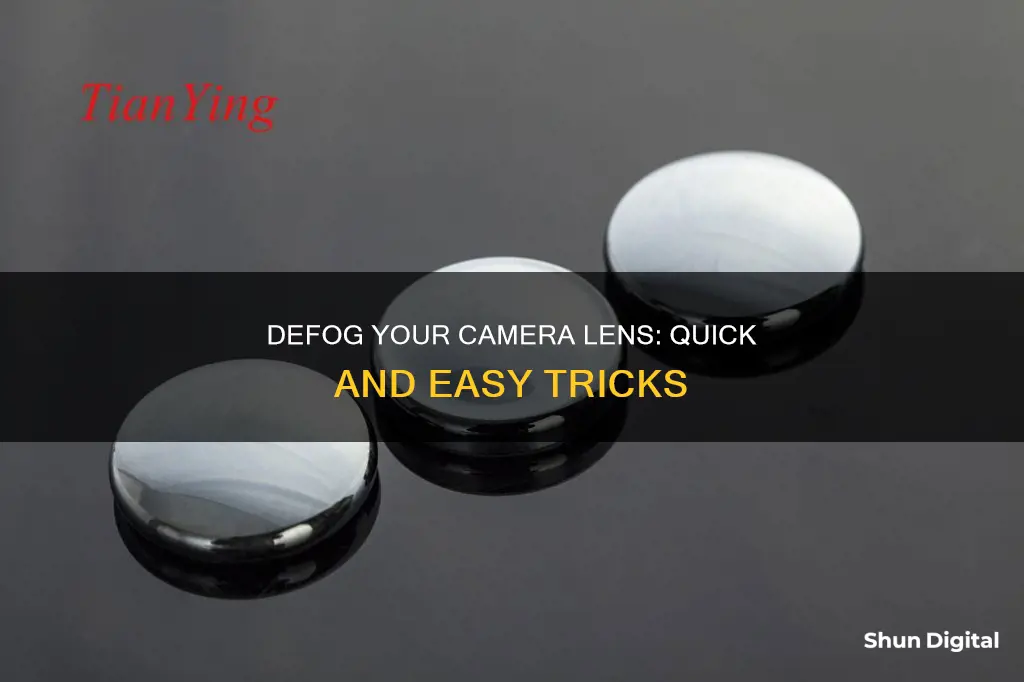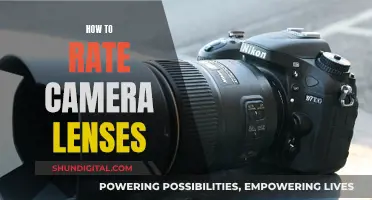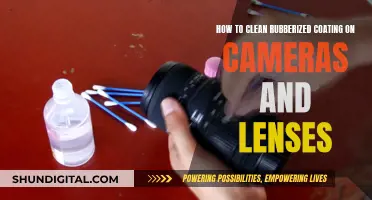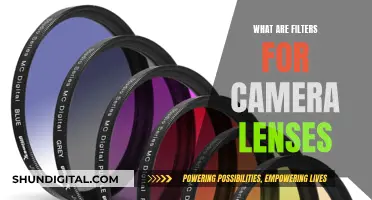
A fogged camera lens can be a frustrating issue for photographers, especially when transitioning between different environments with varying temperatures and humidity levels. This problem is not uncommon, and there are several methods to address it. The key to preventing lens fog is to control the temperature of your gear, allowing it to acclimate to the new environment gradually. This can be achieved by placing your camera in a bag and letting it sit in the new environment for a while or using sealed bags with silica gel packets to absorb moisture. Additionally, you can utilize heating methods like hand warmers, USB heating strips, or simply letting your lens sit in direct sunlight. In cases where the fog is a result of a smudge or fungus, simple cleaning methods or low-toxin agents like vinegar can be used.
What You'll Learn

Let your camera acclimate to the temperature outside
One of the most common causes of lens fog is a drastic change in temperature and humidity. For example, when you go outside to shoot in hot and humid weather after being in a building or car with the AC on. To avoid this, you can let your camera acclimate to the temperature outside before shooting.
If you know you're going on location to shoot and there will be a significant change in climate, it's best to leave your camera in the trunk of your car or outside prior to shooting to allow it to adjust to the new temperature gradually. This way, you reduce the chances of your gear fogging up.
It's important to note that you shouldn't leave your camera equipment unattended in your car for too long, as heat builds up quickly. If you must leave it in the car, keep it in a gear bag or camera bag, which will help insulate it and protect it from theft. You can also add a cooler (without ice) and drape a white towel over it for additional protection from overheating.
Additionally, when going from a cold environment to a hot and humid one, you can use a plastic ziplock bag and let your lens sit in the sun for a few minutes. The condensation will form on the bag instead of the lens. You can also place silica gel packets in the bag to help absorb moisture.
Welding and Cameras: Can Welding Damage Camera Lenses?
You may want to see also

Use a lens cloth to wipe away condensation
If you're in a pinch and need to defog your camera lens, one quick solution is to use a lens cloth to wipe away the condensation. This method is not recommended by all, as it may simply spread the moisture around and leave streaks on the lens that then need to be removed. However, if you are careful, it can be effective.
Firstly, make sure you are using a specialised lens cloth, which can be purchased from camera shops or online. Do not use tissues or other clothing, as these can scratch the lens. Before you begin, wash and dry your hands thoroughly, using lotion-free soap to avoid leaving any residue on the lens.
Next, breathe on the lens to create condensation in the same way you might fog up a mirror in a steamy bathroom. Then, gently rub the lens with the cloth, ensuring you clean every part, including the nose pads and the temples of the frame. Pay particular attention to the area where the edge of the lens meets the frame, as dust, debris, and skin oils can accumulate here.
Once you have finished wiping the lens, rinse it under a gentle stream of tap water to remove any remaining dust or soap residue. Shake the lens to remove excess water, and then dry it carefully with a clean, lint-free towel. Microfibre cloths are ideal for this purpose, as they dry lenses effectively and trap oils to avoid smearing.
Finally, inspect the lens again for any remaining streaks or smudges. If necessary, remove these with a clean microfiber cloth.
AppleCare: Camera Lens Coverage Explained
You may want to see also

Store your camera in a ziplock bag
Storing your camera in a ziplock bag is a great way to protect it from the elements, especially moisture. However, it's important to note that not all ziplock bags are created equal – some are better at preventing moisture build-up than others. Using a ziplock bag with silica gel packets or uncooked rice can help absorb any moisture that might be trapped inside the bag, but it's crucial to ensure the camera is dry before sealing it inside.
- Choose the Right Bag: Select a ziplock bag that is slightly larger than your camera to accommodate the entire device. For a DSLR with a medium zoom lens, a 1-gallon size bag should be sufficient.
- Prepare the Camera: Ensure your camera is turned off and dry before placing it in the ziplock bag. If there is any moisture on the camera, gently wipe it off with a soft cloth.
- Add Silica Gel or Uncooked Rice: Place a few silica gel packets or a small bag of uncooked rice inside the ziplock bag to absorb any moisture. Silica gel can be recharged by placing it in the oven, making it a cost-effective option.
- Seal the Bag: Carefully seal the ziplock bag, ensuring that the closure is tight and secure. You can add an extra layer of protection by wrapping the sealed bag with tape.
- Store in a Safe Place: Place the sealed camera bag in a safe location, such as your camera bag or a dry box. Avoid exposing it to extreme temperatures or direct sunlight.
- Acclimate Before Use: When you need to use the camera, take it out of the ziplock bag and allow it to acclimate to the new environment gradually. Avoid sudden temperature changes to prevent condensation.
- Wipe the Lens: Before using the camera, gently wipe the lens with a microfiber cloth to remove any dust or residue that may have built up during storage.
- Regular Maintenance: Check your camera and ziplock bag periodically to ensure the bag remains sealed and there are no signs of moisture build-up. Replace the silica gel packets or uncooked rice as needed.
- Long-Term Storage: If you plan to store your camera for an extended period, consider investing in a specialised camera storage bag or case that provides extra padding and protection.
- Battery and Memory Card Care: Remove the battery and memory card from your camera before storing it for extended periods. Store them separately in a dry and safe place to maintain their performance and longevity.
Microscopic Dust: A Camera Lens Issue?
You may want to see also

Use silica gel packets to absorb moisture
Silica gel packets are a great way to absorb moisture and prevent your camera lens from fogging up. They are especially useful if you're storing your camera equipment for long periods of time. Silica gel is a desiccant, which means it has the unique ability to absorb and hold water molecules. This helps to keep your camera lens dry and free from condensation.
You can buy silica gel packets in a variety of sizes, ranging from 3 grams to 1000 grams. The amount of silica gel you need will depend on the size of the container or bag you're using to store your camera. It's always better to overestimate the amount of silica gel and use a larger packet or multiple packets. That way, you can be sure that there's enough silica gel to absorb any moisture in the container.
When using silica gel packets, it's important to make sure that the environment is adequately isolated. If the container is not sealed properly, the silica gel packets may not work effectively. Additionally, if you're using pre-used silica gel packets, make sure they're not already fully saturated with moisture. To check, you can weigh them and see if they're about 20% heavier than their original weight. If they are, you'll need to regenerate them by baking them in the oven or microwave before use.
To use silica gel packets for your camera lens, place them inside an airtight container or plastic bag along with your camera equipment. Leave the setup for some time to allow the silica gel to absorb any moisture or condensation. This process may take a few hours or a few days, depending on the level of moisture. If you're in a hurry, you can try speeding up the process by using a hairdryer or hand warmer to warm up the lens and evaporate the condensation.
By following these steps and using silica gel packets, you can effectively absorb moisture and prevent your camera lens from fogging up. This will help ensure that your camera equipment stays dry, protected, and ready for use whenever you need it.
Camera Lenses: Scratch-Resistant or Not?
You may want to see also

Keep your camera away from AC vents
Keeping your camera away from AC vents is a good idea for a few reasons. Firstly, if you're using an AC vent to try and defog your camera lens, it might not be the best method. AC vents can increase the pressure in your ducts and change the airflow in your home, which could lead to inefficiencies in your heating or cooling system. This could cause your energy bills to rise.
Instead, if you're moving from a cold to a warm environment, or vice versa, try to plan ahead. Leave your camera in the trunk of your car or out of the AC to give it time to adjust to the temperature change. You could also place your lens in a plastic ziplock bag and let it sit for a few minutes in the sun, or in the shade if you're moving from a cold to a warm environment. The condensation should form on the bag and not the lens. Silica gel packets can also be useful to absorb moisture.
If you're in a hurry, you could try using a hairdryer or hand dryer to warm up the camera and lens, but be careful not to get too close to the lens as you could damage it.
Another option is to use a heating strip. Coowoo is a brand of affordable heating strips that can be powered by a USB 5V port and wrapped around your lens to prevent fogging.
Leica Lenses: Panasonic Cameras' Secret Weapon?
You may want to see also
Frequently asked questions
The best way to combat a fogged-up lens is to plan ahead. If you know you're going to be shooting in a different climate, let your camera sit in that environment for a while so it can acclimate.
If you can't leave your camera out, place it in a sealed plastic bag with silica gel packets and let it sit for a while. This will allow your gear to slowly adjust to the new environment without condensation forming.
If your lens has already fogged up, refrain from wiping the lens as this may cause scratches. Instead, try using a microfiber cloth to gently wipe down the lens. You can also try placing the lens in front of a fan or a source of warm air, like a hand dryer, to speed up the evaporation process.
If your lens has fogged up internally, you will need to disassemble the lens and clean it. This should be done with extreme care and precision to avoid scratching the lens or damaging the individual components. If this does not work, the fog may be due to irrevocable damage to the lens coating.
To prevent your lens from fogging up in the future, try using a lens hood or heating strips to control the temperature of your gear. You can also store your camera in a dry environment and avoid taking it directly from a cold to a warm and humid environment.







